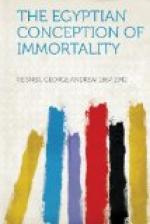The power of the monarchy had been weakening during the Fifth and Sixth Dynasties, partly owing to the dissipation of national resources by royal extravagance, partly owing to other causes. After the Sixth Dynasty, the country was clearly in a period of economic depression; and the government was broken up into a series of nearly independent baronies corresponding roughly to the later division into provinces or nomes. Our material is scanty. The tombs of very few great men have been found. But when in the Twelfth Dynasty an abundance of material is at hand, we see, alongside the old forms of the burial customs, the use of the pyramid texts on the inside walls of the coffins of the great man. It was now possible for the ba of the great landed noble to seek refuge with the gods in the northwest heavens and share their life.
The increasing importance of Abydos as the burial place of Osiris is of still greater significance. The tomb of a king of the First Dynasty was identified by the priests as the actual burial place of Osiris. Many great people made graves for themselves in the same field; or, if they lived at a distance, built empty cenotaphs there. A great temple of Osiris stood near by, and became the centre of the celebration of mysteries illustrating the death and revival of Osiris. Fortunately, a certain high official named I-kher-nofret has left us an account of the Osiris passion-play as performed under his oversight in the nineteenth year of Sesostris III, nearly two thousand years before Christ [See Schafer’s article, “Die Osiris-mysterien,” in Sethe’s Untersuchungen zur Geshichte Aegyptens, IV, 2, pp 1-42.]. The play began by the procession of the statue of the jackal-god Wep-wawet (the road-opener) going forth to help his father Osiris. Then the statue of Osiris himself in the Neshemet boat came forth as triumphant king of the earth. Sham battles took place referring to the conquest of the earth by Osiris. These processions were only introductory. The principal procession took place on the following day (or days), when Osiris went forth to his death at Nedit. The actual death scene certainly took place in secret. But when the dead body was found, the multitude joined in the wailing and the lamentations. The god Thoth went forth in a boat and brought back the body of Osiris. The body was prepared for burial and taken in funeral procession to the grave at Peker. Osiris was avenged on his enemies in a great battle on the water at Nedit. Finally, the god, his life revived, comes from Peker in triumphant procession and enters his temple at Abydos.
Osiris mysteries were celebrated at other places, at least in later times and perhaps even in the Middle Empire; but it is not easy to discern the part these mysteries played in the Middle Empire in the beliefs of the common people regarding their immortality. The Osiris story was one of the most widespread in Egypt, and, powerful in its effect on the feelings of all classes, was certain, sooner or later, to prepare the way for a general belief in a better immortality; but if we may judge from the burial customs, the great mass of the people still believed merely in an underworld, Earu, a duplicate of the earthly life, but with greater possibilities of danger and evil.




